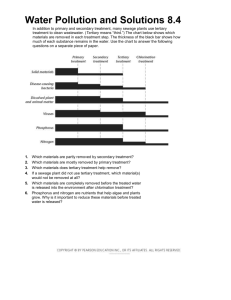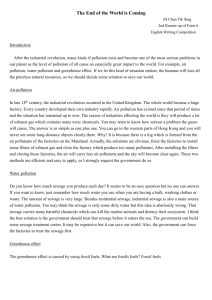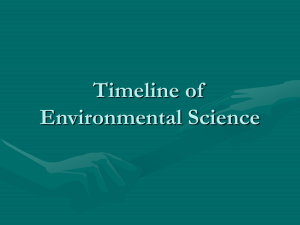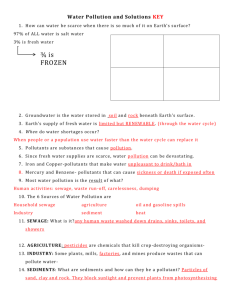CONTROLLING WATER POLLUTION
advertisement
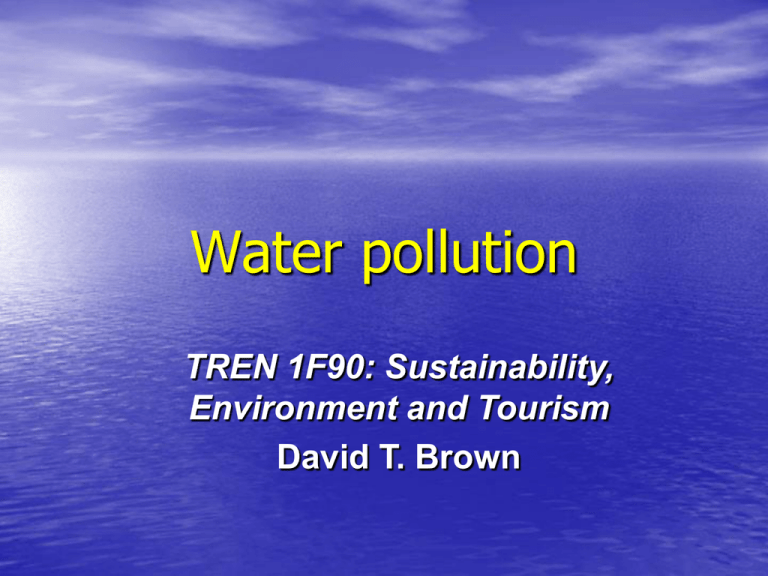
Water pollution TREN 1F90: Sustainability, Environment and Tourism David T. Brown B. CONDENSATION C. PRECIPITATION A. EVAPORATION 2. Atmospheric radioactive 1. Dust particles and gases dust particles (high filtered out of atmosphere altitudes) by falling snow 3. Suspended solids 4. Terpenes, phenolics, and eroded by falling other natural VOCs 5. Mine acid tailings and water from trees waste leached into waterways 6. Industrial effluent gases washed from atmosphere Leaching 9. Natural aeration 8. (falls, rapids)of soil chemicals and decaying vegetation affecting dissolved gases 7. Crop 10. Industrial wastespraying water and discharged into water dusting bodies or municipal (herbicides, sewers pesticides) by air 11. Dust particles 12. andFertilizers and biocides 13. Barnyard and feedlot manure from agricultural land airborne solids washed 14. Human waste from out of atmosphere 15. Sea water from overdraft domestic septic systems of underground aquifers 16. Thermal pollution from power plants and industry 17. Methane and other gases from marshes and swamps 19. Storm 18. Municipal sewer wastewater runoff treatment plant effluent 21. Vehicle exhaust / fossil fuel emissions 22. Oil leaks and spills from tanks and rigs 20. Marine salt particles and spray CONTROLLING WATER POLLUTION Water Pollutants • toxics • nutrients • anthropogenic origin (e.g. industrial • suspended matter effluent, sewage) • pathogens • thermal pollution • natural origin (e.g. silt, mineral nutrients, • dissolved gases wild animal wastes) Significant concern in the tourism industry • Water quality • Water quantity • Aesthetic concerns • Disease and pathogens • Local equity issues •Tourism operations: Water and tourism • Quantity: ensuring that local water supply needs are not compromised by tourist demands in resorts (e.g., island resorts) • Quality: ensuring that local water treatment infrastructure can handle additional burden of sewage from tourism Water and tourism Case study: cruise ship pollution issues CRUISE SHIP ISSUES: BIG SHIPS 3.6 Canadian fields long 360 football m long 6296 passengers World's biggest cruise ships: Royal Carribean’s “Oasis of the Seas“ (2009) “Allure of the Seas” (2010) CRUISE SHIP ISSUES: BIG SHIPS World's 2nd biggest cruise ship: Royal Carribean’s "Freedom of the Seas“ 338.91 m / 3,634 passengers BIG SHIPS World's 3rd largest cruise ship: Cunard’s “Queen Mary 2” 345 m / 3056 passengers BIG SHIPS = BIG POLLUTION 19 to 26 litres • Sewage dumped per passenger per day 1.58 billion litres • Sewage dumped per year 4.8 km (3 miles) • Distance from shore where raw sewage is dumped 0 km • Distance from shore where treated sewage and raw graywater are dumped ENVIRONMENTAL IMPACTS OF CRUISE SHIPS Waste discharge in international waters is controlled under Annex V of the MARPOL convention (1988) Liquid wastes: Gray water - from dishwashing, showers Sewage – from toilets • Within 4.8 km: treated with MSDs (marine sanitation devices) to dissolve lumps and reduce bacteria levels) • Beyond 4.8 km: no treatment is required (direct discharge of raw sewage) Oil – from bilge water in hull of ship Hazardous liquid wastes – dry cleaning, photo processing paints, solvents, pool chemicals, etc. ENVIRONMENTAL IMPACTS OF CRUISE SHIPS Solid wastes: • Inorganic (glass, aluminum and steel cans, and plastics) • Organic (primarily food wastes) Barred from dumping: • plastics (anywhere at sea) • floatable garbage within 25 miles (40 km) of shore Permitted to dump: • garbage ground into pieces smaller than 2.5 cm when three miles (4.8 km) from shore • unground garbage when they are at least 12 miles (19 km) from shore ENVIRONMENTAL IMPACTS OF CRUISE SHIPS Waste discharges to air also a problem Diesel ‘Master’ and ‘slave’ engine emissions • Master engines: used for propulsion • Slave engines: used for electricity generation Marine engines generally burn cheap residual fuel oil of low quality (not standard diesel). ENVIRONMENTAL IMPACTS OF CRUISE SHIPS Waste discharges to air include: Solid waste incinerator emissions: • gaseous emissions • particulate emissions • greenhouse gases Annex VI of MARPOL (International Convention for the Prevention of Pollution From Ships) is concerned with the prevention of air pollution from ships. You might expect it of antique vessels… Passenger excursion ship (1912 steamer TSS Earnslaw) on Lake Wakatipu, near Queenstown, New Zealand …but modern cruise ships?!? A cruise ship in Milford Sound, New Zealand, with stack exhaust gases constrained by an inversion layer Per unit of time, a cruise ship’s diesel engines can emit as much exhaust as 10,000 cars, even when idling in port. A rare dockside utility connection (found on 53 Swedish ships; 0 US ships) 2 6 3 • Number of cruise lines equipping ships to plug into shorepower • Number of cruise ships equipped to plug into shorepower • Number of U.S. ports equipped with shoreside power hook-ups for cruise ships Controlling Water Pollution • Upstream: • before the problem occurs Downstream: after the problem occurs Upstream Methods of Controlling Water Pollution • process modification in industry: elimination of pollutants and toxics • avoidance of direct discharge into: – water bodies – storm sewers – sanitary sewers • identification of storm drains (e.g. Yellow Fish Road project) Upstream Methods of Controlling Water Pollution • decoupling of storm and sanitary sewers • runoff control: – increasing absorptive surfaces – avoiding erosion – maintaining streambank and shoreline vegetation • legislation and regulation: guidelines and laws establishing limits on discharge Downstream Methods of Controlling Water Pollution • effluent treatment processes: – mechanical: filtering, gravity separation – chemical: flocculation, coagulation – biological: microbes or macrophytes aerobic or anaerobic – disinfection: chlorination, ozonation, etc. (pathogen control) Downstream Methods of Controlling Water Pollution • domestic sewage treatment: – primary: straining and settling of solids – secondary: removal of biodegradable organic matter and nutrients – tertiary: removal of residual dissolved nutrients and pollutants Downstream Methods of Controlling Water Pollution • ‘physical plant’/ ‘engineered’ approach (usually centralized, large scale) • ‘constructed wetland’ approach (centralized or decentralized, large or small scale) S E W A G E Neolithic revolution • small towns and settlements -> human waste control generally nonproblematic S E W A G E “In days of old When knights were bold And toilets weren’t invented They’d leave their loads Upon the roads And walk away contented.” S E W A G E Post - Neolithic revolution: Large towns and cities -> human waste control became a problem high-density living required technologies for handling human wastes in urban areas: • chamber pots and open gutters • pit privies / trench latrines/ outhouses • septic systems and variants • centralized sewage collection and treatment systems Methods of Managing Sewage: Small scale • Temporary / short term: – – – – packing it out single-use holes pit privies trench latrines Meyer, Kathleen. 1989. How to shit in the woods : an environmentally sound approach to a lost art. Ten Speed Press, Berkeley, Calif. Methods of Managing Sewage: Small scale • Long-term – – – – – outhouses settling ponds septic tanks septic fields composting toilets van der Ryn, Sim. 1978 (republished and revised 1999). The Toilet Papers: Recycling Waste and Conserving Water. Chelsea Green Publishing, Vermont. Online edition available at www.brocku.ca/tren/courses/tren3p14/2006/ToiletPapers.pdf Waterless toilet technologies Clivus Multrum composting toilet • converts human and organic wastes into odourless compost Waterless toilet technologies • • • • • Scalable Waterless Low energy Suitable for remote areas Now CSA approved Primary Sewage Treatment GRIT SETTLING CHLORINATION BAR TANK TANK SCREEN CHAMBER outflow Raw sewage Sludge SLUDGE DIGESTER SLUDGE DRYING BED Secondary Sewage Treatment GRIT SETTLING AERATION SETTLING BAR TANK TANK TANK 2 SCREEN CHAMBER Raw sewage CHLORINATION TANK Methane SLUDGE DIGESTER outflow Air pump SLUDGE DRYING BED Activated sludge Constructed Wetland Constructed Wetland EXPERIMENTAL CELLS S.W.A.M.P. (SEWAGE WASTE AMENDMENT MARSH PROJECT) Niagara on the Lake, Ontario Constructed Wetland EXPERIMENTAL CELLS Constructed Wetland macrophytes Cattails and Water Hyacinth Large scale constructed wetland Saha Pat Industrial Park, Laem Chabang, Thailand Settling tank Saha Pat Industrial Park, Laem Chabang, Thailand Sludge dewatering and drying Saha Pat Industrial Park, Laem Chabang, Thailand Aeration pond Saha Pat Industrial Park, Laem Chabang, Thailand Outflow into constructed wetland Saha Pat Industrial Park, Laem Chabang, Thailand Large scale constructed wetland Saha Pat Industrial Park, Laem Chabang, Thailand Water and Legislation • multijurisdictional: • federal, provincial, and municipal areas of responsibility multifaceted: laws and regulations deal with – conservation and management of water resources; protection of aquatic life – pollution and liquid discharge – drinking water standards



